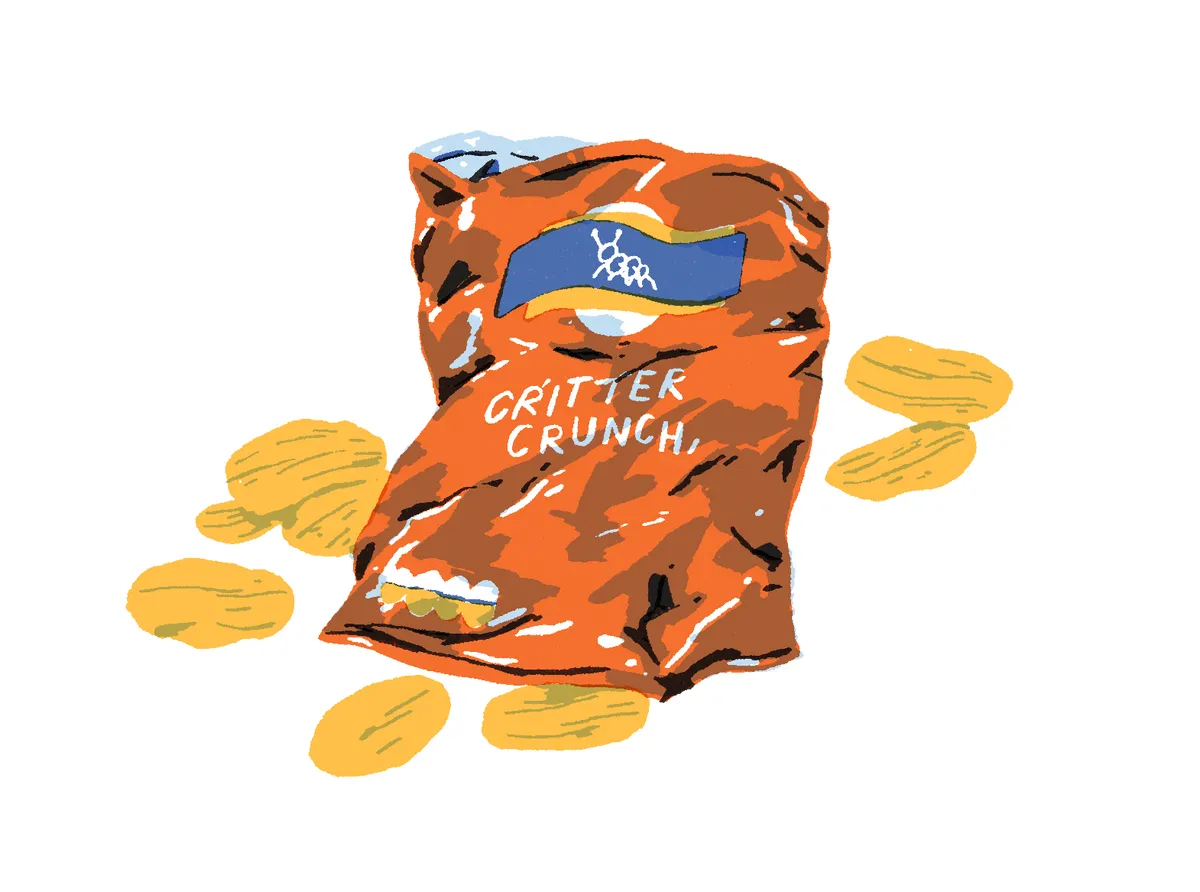Hesitantly, I reached my jittery hand into the termite mound, coaxed by my field guide to pull out one of the tiny, plump insects. Going against all of my natural instincts, I put the miniscule bug into my mouth and began to chew.
While the termites did not deliver the promised taste of peanut butter, I had to admit that these little creatures did pack a salty punch that wasn’t entirely unpleasant. My apprehension about eating them had absolutely nothing to do with their taste or texture, but everything to do with my preconceived ideas about eating bugs.
Why aren't insects on the menu more often?
It got me thinking. Where have these ideas come from? In a world where we eat birds, mammals and even sea creatures such as prawns – themselves referred to as ‘insects of the sea’ – why does munching on an insect evoke such feelings of revulsion? And, more significantly, with two billion people on our planet happily consuming insects as part of their daily diets, why is this fare not served up more regularly on western plates?
Humans across the planet were once hunter-gatherers, with insects widely featuring on the menu. Studies have shown that early hominins (an ancestor of humans who lived about two million years ago) used tools made of bone to dig into termite mounds, while many examples of insect-eating appear in religious literature in Christian, Jewish and Islamic faiths.
Then, over 6,000 years ago, agriculture swiftly spread from its origins in the Fertile Crescent – a scythe of land in the Middle East – to Europe, whereupon it quickly became apparent that, when it came to the needs of a growing human population, domesticating livestock was far more beneficial than catching and eating insects.
Farm animals delivered high yields of meat and milk products; provided skins, wool and fur for clothing; and were useful as a means of transport. They were also far more reliable in comparison to the unpredictability and seasonality of insects – particularly in colder climes, such as the UK, where many species lie dormant or die in winter. Insects were soon relegated as pests that threatened food production, rather than being considered a source of food themselves.
Fast forward to today and insects are slowly returning to the table in the West. By 2050, it’s predicted that there will be nine billion people on Earth. Put simply, our current methods of food production will not be able to cater for such a vast population in a sustainable way.

Why insects could be an ecological menu choice
Insects offer a promising alternative to a low-ecological-footprint diet: they are genetically very distinct from humans, so viruses are unlikely to make the jump; they produce only small amounts of greenhouse gas, compared to livestock (to yield just 1kg of protein, a single cow produces 2,850g of greenhouse gas, while insects produce just 1g); they can be fed on organic waste, such as vegetable peelings; and they require only tiny quantities of water. We simply need to accept that eating them is okay.
Our current eating habits are suffocating the planet. Food production is responsible for almost 60 per cent of global biodiversity loss, and contributes to overfishing, climate change and water shortages. In the UK, we’re eating more than two-and-a-half times more meat than the global average, a habit that is to blame for much of the environmental impact of our food system.
The way we produce and consume meat often requires huge amounts of land to grow animal feed, such as soy and maize. Indeed, growing livestock feed is the biggest driver of deforestation on the planet. Fifty per cent (51 million km2) of the Earth’s habitable land is currently given over to agriculture; of that, more than 70 per cent can be attributed to the meat and dairy industry. Meat production also guzzles oceans of water – to produce just 1kg of beef protein, you’ll need an eye-popping 22,000 litres of H2O. For the same amount of cricket-based protein, you’ll need just 1 litre.
Studies on human behaviour show that the way we view our food and the decisions we make about what to eat are controlled by different parts of the brain. It can be hard to change dietary habits, despite what we know about the negative environmental impacts of our choices, as these are already so ingrained. Our decisions are further reinforced by culture, social norms and the influences of the people around us.
Joanna Trewern, WWF-UK’s sustainable diets and behaviour change specialist, is researching how food companies can help consumers to veer towards more sustainable diets. “Society has significant and often overlooked influences on food choice,” she says. “These include mass advertising, such as television adverts, internet pop-ups and billboards, as well as menu design and the layout of canteens and supermarkets. For example, placing a product at the end of an aisle in a supermarket subconsciously encourages customers to buy it. In order to change behaviour at scale, it’s vital to analyse, understand and adapt food environments so that they encourage healthier and more sustainable choices.”
But a revulsion towards eating bugs is a largely western phenomenon. Two billion people across South America, Asia and Africa currently eat insects regularly and generally always have done. Their choice to consume something with six legs rather than four has nothing to do with a lack of alternative food options or income – many are even considered delicacies.
Ants, for example, are highly sought after in many parts of the world, and about 80 grasshopper species are consumed across the globe. An estimated 9.5 billion mopane caterpillars are harvested annually in South Africa, while in the Chiapas region of Mexico, locals tuck into 27 types of caterpillar, alongside red and white maguey worms. The larvae of yellowjacket wasps are a staple in Japan and, as of 2012, there were some 20,000 cricket farmers in Thailand.
We may recoil at the idea of eating insects, but many of us are consuming them without knowing it. Honey, in its truest essence, is simply bee vomit. And if you’ve ever eaten strawberry pencil sweets, pink marshmallows, strawberry yoghurt or red velvet cake, then you’ve probably consumed the cochineal beetle. This species, dried and crushed, produces the red dye (listed as ‘carmine’ or ‘E120’ in lists of ingredients) that gives those food items their characteristic pink hue – and allows food manufacturers to state that they only use natural colourings.
But the fact that we’re consuming the cochineal beetle only in a form used for processed foods means we’re missing out on the nutritional benefits this species could provide. Insects, after all, are highly nutritious. They’re loaded with fibre (largely the insoluble chitin in their exoskeletons), vitamins, and minerals such as calcium, iron and zinc. When dried, crickets contain up to 69g of protein per 100g, compared to beef, which delivers just 19.4g per 100g. And, perhaps surprisingly for their size, insects are also a complete protein, containing all nine essential amino acids.
As well as their nutritional value, rearing insects for human consumption is far friendlier to the environment than the current food-production systems that we have in place. Insects play a vital role in the world's natural ecosystems by processing and decomposing biological waste – including leaf litter, dead wood and even animal carcasses. Added to that, they can convert feed to protein more efficiently than livestock: thanks to their cold-blooded body structure, they don’t use energy to maintain body temperature, and can therefore devote more to other processes.
So, what would incorporating insects into our diet actually look like?
There are currently about 1,900 known edible insect species on our planet, yet the lines as to what we in the UK and EU can and cannot legally consume have been blurred by the 2018 Novel Foods (England) Regulations. This new legislation applies to all categories of foods that “were not used for human consumption to a significant degree” within the EU before 15 May 1997.
Waters have been muddied further by Brexit, which means different regulations for insect farms in the UK and the EU.
It's a signal that things are moving in the right direction and there are more than 20 applications for edible insects currently awaiting approval.
In the meantime, the good news is that we do have some brilliant sources of insect protein native to the UK, and farming insects for consumption is surprisingly easy.
Tiziana Di Costanzo, who runs urban insect farm Horizon Insects, went from breeding mealworms in her utility room to building a specialised shed in her garden, in which she offers insect cookery classes and sells fresh ones ready for the pot, as well as insect breeder starter kits. “Mealworms are by far the easiest to farm due to the smaller space requirements to keep them healthy,” she says. “In comparison, crickets are territorial, so they need a lot more space to be ethically farmed.”
Because one female mealworm beetle lays about 500 eggs, these creatures produce protein relatively quickly. Horizon Insects is still breeding, consuming and selling from the same batch of insects it purchased back in 2012. For a small initial outlay of £14 for 50 beetles, you could have a source of sustainable protein for life.
All you need is a heat-controlled room (such as a utility or converted garage) and leftover peelings, and you have a versatile and tasty ingredient that can be roasted, fried or ground into flour.
Tiziana’s interest in insect cookery has mainly come from a desire to understand why some cultures enjoy insects in their diets. “We have clients who have visited countries such as Mexico and Thailand and tried insects, and crave them again,” she explains. “We’ve also had vegetarians and vegans who want to explore different food options that fit with their environmentally beneficial diet and food choices.”
It certainly seems to be an exciting time for emerging independent insect-based food companies. A number of small online retailers – there are about 25 insect-based food companies in the UK – offer a range of items, such as crackers made with cricket flour; flavoured mealworm snack bags; and even insect protein powder. According to Sarah Beynon, director of Bug Farm Foods, there is a growing acceptance of insect-based food. “Consumers are being led more and more by the sustainability and nutritional benefits of insect protein,” she says.
While there isn’t enough science yet to conclude the environmental impact of large-scale insect consumption, there is certainly research to demonstrate the huge environmental benefit that eating insects has in comparison to our overconsumption of meat and dairy. But as American naturalist Joseph Bequaert wrote in his paper ‘Insects as Food’ in 1921: “What we eat is, after all, more a matter of custom and fashion than anything else.”
Awareness and understanding that it is merely our societal and cultural norms that encourage us to form specific opinions about certain products is crucial in breaking down these barriers to alternative food sources and opening our minds to different ways of producing food that is good for our health – and that of our planet.
Illustrations Harry Tennant
